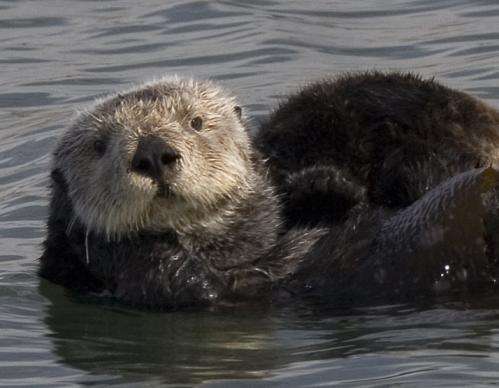New study demonstrates wild sea otters could help generate millions of dollars for local communities

A new study led by researchers at the Monterey Bay Aquarium and Middlebury Institute of International Studies’ Center for the Blue Economy finds that sea otters attract recreational visitors to Elkhorn Slough, generating more than $3 million in revenues to local communities annually. Published in the Journal of Coastal and Ocean Economics, the study assessed the economic value provided by recreational visitors traveling to Elkhorn Slough, a central California estuary where people can enjoy kayaking, hiking, fishing, and other recreational activities. Researchers revealed that the opportunity to view sea otters is a major reason for people appreciating their visit to the slough, and this correlated with the financial value visitors placed on protecting the area and sea otters.
The benefits of wildlife recovery are usually seen through the perspective of ecosystem recovery. Documenting economic benefits, however, is integral for a variety of community groups, including recreational businesses, hotels, and restaurants. Ecotourism industries have the potential to see large impacts from the presence of recovering species such as sea otters.
“The economic benefits from such a small area is remarkable, and the role sea otters play in influencing how visitors value their visit demonstrates another benefit—on top of their ecological impact—that sea otters can provide to their local communities,” said Jess Fujii, Monterey Bay Aquarium’s Sea Otter Program Manager.
Researchers started by calculating how much visitors were spending at Elkhorn Slough and how it contributed to the local economy. Adjusting for party size and including reported expenses like meals, rental and tour fees, and transportation, results showed that more than $3 million of direct and indirect spending can be attributed to Elkhorn Slough visitors. Additional indirect economic gains include employment related to recreational activity in the slough, including tour guides and kayak rental agents.
The study also evaluated economic impacts by surveying the importance sea otters played in the visitor experience and calculating a visitor’s willingness to pay a hypothetical fee.
“What we saw is that people are very drawn to sea otters and willing to spend a significant amount of money to view them. This has big positive impacts for the local economy,” said Jason Scorse, Director of the Center for the Blue Economy (CBE).
Several students in the Middlebury Institute’s Environmental Policy & Management program and one from the University of Galway contributed to the research by conducting on-site interviews and surveys in Moss Landing.
Survey respondents ranked seeing a sea otter high among other attributes to Elkhorn Slough. The ranking was often dependent on whether the respondent had seen a sea otter and more than 70% of respondents reported seeing an otter, positively impacting the “sea otters” ranking. Calculating a willingness to pay a hypothetical fee allowed researchers to understand the perceived value of protecting Elkhorn Slough or sea otters. This hypothetical fee of roughly $28-29 along with an average annual visitation of 45,000 amounted to a potential value of $1.29 million to $1.35 million per year. The willingness to pay increasing fees was associated with higher scores of viewing sea otters as well. The positive relationship between sea otter ranking score and willingness to pay supports that viewing sea otters also has the potential to impact the financial value placed on preservation of species and land.
“Tourism is a key part of many coastal community economies. As sea otters eventually recover to more parts of their historical range, understanding the economic value of recreational tourism and viewing wildlife can inform strategies for other communities,” Fujii added.
Elkhorn Slough was chosen as a case study because of its known interest to a variety of user types, and the presence of diverse wildlife. The 12-kilometer long tidal estuary is the largest wetland on the California coast south of San Francisco Bay. The slough supports a resident population of sea otters that has grown over two decades through the protections of the Marine Mammal Protection Act and Endangered Species Act, as well as efforts of the Monterey Bay Aquarium’s Sea Otter Program. The Sea Otter Program primarily used Elkhorn Slough as a release site for rescued and surrogate-reared juvenile sea otters, and in turn contributed significantly to the population growth in the estuary from 2002-2016.
With the expansion of sea otters into their historical range, either through natural means or reintroduction efforts, the benefits of their recovery are usually seen through the perspective of ecosystem recovery. New areas with limited to no marine recreational industries could financially benefit from new tourism opportunities. From 2010 to 2019, visitor-supported recreational businesses in Elkhorn Slough grew dramatically. During that same time, sea otter numbers increased and eelgrass habitat health improved, which may have also attracted more visitors.
“Elkhorn Slough is an excellent case study to understand how recovering a native species can improve ecosystem health and support a robust recreational tourism industry,” Fujii said.
Citation:
New study demonstrates wild sea otters could help generate millions of dollars for local communities (2023, June 7)
retrieved 7 June 2023
from https://phys.org/news/2023-06-wild-sea-otters-generate-millions.html
This document is subject to copyright. Apart from any fair dealing for the purpose of private study or research, no
part may be reproduced without the written permission. The content is provided for information purposes only.
For all the latest Science News Click Here
For the latest news and updates, follow us on Google News.

